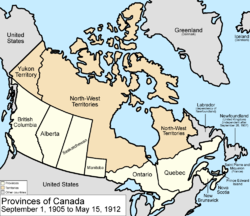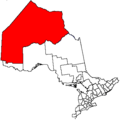Kenora District | |
|---|---|
 Location of Kenora District in Ontario | |
| Coordinates: 54°N89°W / 54°N 89°W | |
| Country | |
| Province | |
| Region | Northwestern Ontario |
| Created | 1907 |
| Government | |
| • MPs | Eric Melillo (CPC), Gaétan Malette (CPC), Patty Hajdu (LPC) |
| • MPPs | Greg Rickford (PC), Guy Bourgouin (NDP), Sol Mamakwa (NDP) |
| Area | |
| • Land | 395,432.07 km2 (152,677.18 sq mi) |
| Highest elevation | 505 m (1,657 ft) |
| Lowest elevation | 0 m (0 ft) |
| Population (2021) [1] | |
• Total | 66,000 |
| • Density | 0.2/km2 (0.52/sq mi) |
| Time zones | |
| West of 90° west | UTC-6 (Central (CST)) |
| • Summer (DST) | UTC-5 (Central Daylight (CDT)) |
| East of 90° west | UTC-5 (Eastern (EST)) |
| • Summer (DST) | UTC-4 (Eastern Daylight (EDT)) |
| Pickle Lake/ Mishkeegogamang | UTC-5 (Eastern (EST)) |
| Postal Code FSA | |
| Area code | 807 |
| Largest communities [2] | Kenora (15,177) Dryden (8,195) Sioux Lookout (5,183) |
Kenora District is a district and census division in Northwestern Ontario, Canada. The district seat is the City of Kenora.
Contents
- Politics
- Geography
- Subdivisions
- First Nations reserves
- Patricia Portion
- Demographics
- Economy
- Mining
- Transportation
- See also
- References
- External links
It is geographically the largest division in Ontario: at 407,213.01 square kilometres (157,225.82 sq mi), it covers 38 percent of the province's area, making it larger than Newfoundland and Labrador, and slightly smaller than Sweden or roughly the land size of California. Kenora District also has the lowest population density of any of Ontario's census divisions (it ranks 37th out of 50 by total population).
The district was created in 1907 from parts of Rainy River District. The northern part (north of the Albany River) only became part of Ontario in 1912 (transferred from the Northwest Territories). [3] The separate Patricia District upon transfer, it was in 1937 annexed to Kenora District and known sometimes as the Patricia Portion. [4]



